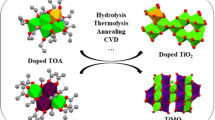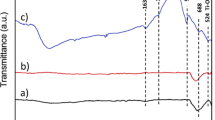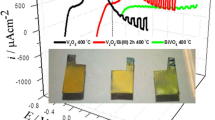Abstract
Calcination of hybrid organic–inorganic Titanium-Ethylene Glycol (Ti-EG) thin films yield non-stoichiometric titania with deep valence band maximum (VBM) with down-shift of up to 450 meV relative to stoichiometric TiO2. We previously reported the enhanced photocatalytic (PC) reactivity of these materials by demonstrating direct photocatalytic production of H2O2 and high degradation rates of organic molecules (Ishchuk et al. in ACS Nano 6:7263–7269, 2012; Kaynan et al. in J Mater Chem A 2:13822–13826, 2014; Sarkar et al. in J Phys Chem C 120:3853–3862, 2016). Here we show that the down shift in VBM is related to strain effects at the metal oxide thin film originating from the calcination process. The deep VBM position, namely high oxidative potential of photogenerated holes allows the study of PC degradation reactions of challenging targets such as Benzoic Acids (BAs) in water and porphyrin monolayers. Systematic study of these systems as probe molecules provide insights regarding the electronic details, including the molecular details, such as ionization potentials, molecular dipoles, and charge densities at the molecular side, and molecule-oxide interactions in determining the overall PC process. The analyses provide insights regarding (i) the role of strain in attaining deep VB titania and, (ii) specific insights regarding PC degradation of relatively robust, high oxidation potential materials on metal oxide (MO) thin film catalysts. Deep-VB oxide materials may pave the way for attaining a promising strategy for extending the use of light energy for removal of organic pollutants and for photocatalysis in general. Specifically, deep VB titania is found to be effective in handling BAs, which is highly challenging due to their chemical robustness, high bio-recalcitrance, and high oxidation potentials making these compounds difficult to degrade by oxidative paths. This combination of properties leads to broad impact on water reservoirs in extensive areas. Therefore, there is an on-going drive to set strategies that utilize nontoxic materials with high degradation activities towards aromatic carboxylic acids.





Similar content being viewed by others
References
Priya MH, Madras G (2006) Kinetics of photocatalytic degradation of phenols with multiple substituent groups. J Photochem Photobiol, A 179:256–262
Tolosana-Moranchel A, Anderson JA, Casas JA, Faraldos M, Bahamonde A (2017) Defining the role of substituents on adsorption and photocatalytic degradation of phenolic compounds. J Environ Chem Eng 5:4612–4620
Tolosana-Moranchel A, Montejano A, Casas JA, Bahamonde A (2018) Elucidation of the photocatalytic-mechanism of phenolic compounds. J Environ Chem Eng 6:5712–5719
Zhao T, Cheng H, Liang Y, Xiong J, Zhu H, Wang S, Liang J, Chen G (2020) Preparation of TiO2/sponge composite for photocatalytic degradation of 2,4,6-trichlorophenol. Water Air Soil Pollut 231:412–425
Mesa JJM, Arias JAG, Rojas HA, Espinosa OEC (2020) Photocatalytic degradation of Phenol, Catechol and Hydroquinone over Au-ZnO nanomaterials. Rev Fac Ing Univ Antioq 94:24–32
Tolosana-Moranchel A, Canle M, Faraldos M, Bahamonde A (2020) Photo-mechanism of phenolic pollutants in natural water: effect of salts. Sep Purif Technol. https://doi.org/10.1016/j.seppur.2020.116868
Ksibi M, Zemzemi A, Boukchina R (2003) Photocatalytic degradability of substituted phenols over UV irradiated TiO2. J Photochem Photobiol A: Chem 159:61–70
Wang N, Zhu L, Huang Y, She Y, Yu Y, Tang H (2009) Drastically enhanced visible-light photocatalytic degradation of colorless aromatic pollutants over TiO2 via a charge-transfer-complex path: a correlation between chemical structure and degradation rate of the pollutants. J Catal 266:199–206
Mrowetz M, Selli E (2006) Photocatalytic degradation of formic and benzoic acids and hydrogen peroxide evolution in TiO2 and ZnO water suspensions. J Photochem Photobiol A: Chem 180:15–22
Mohapatra AK, Nayak J (2018) Anatase TiO2 powder: synthesis, characterization and application for photocatalytic degradation of 3, 4-dihydroxy benzoic acid. Optik 156:268–278
Benhebal H, Chaib M, Salmon T, Geens J, Leonard A, Lambert SD, Crine M, Heinrichs B (2013) Photocatalytic degradation of phenol and benzoic acid using zinc oxide powders prepared by the sol–gel process. Alex Eng J 52:517–523
Zhong J, Zhao Y, Ding L, Ji H, Ma W, Chen C, Zhao J (2019) Opposite photocatalytic oxidation behaviors of BiOCl and TiO2: direct hole transfer vs. indirect OH oxidation. Appl Catal B Environ 241:514–520
Wang KH, Hsieh YH, Wu CH, Chang CY (2000) The pH and anion effects on the heterogeneous photocatalytic degradation of o-methylbenzoic acid in TiO2 aqueous suspension. Chemosphere 40:389–394
Yener HB, Yılmaz M, Deliismail Ö, Özkan SF, Helvacı ŞŞ (2017) Clinoptilolite supported rutile TiO2 composites: synthesis, characterization, and photocatalytic activity on the degradation of terephthalic acid. Sep Purif Technol 173:17–26
Chhor K, Bocquet JF, Colbeau-Justin C (2004) Comparative studies of phenol and salicylic acid photocatalytic degradation: influence of adsorbed oxygen. Mater Chem Phys 86:123–131
Vione D, Minero C, Maurino V, Carlotti ME, Picatonotto T, Pelizzetti E (2005) Degradation of phenol and benzoic acid in the presence of a TiO2-based heterogeneous photocatalyst. Appl Catal B: Environ 58:79–88
Velegraki T, Mantzavinos D (2008) Conversion of benzoic acid during TiO2-mediated photocatalytic degradation in water. Chem Eng J 140:15–21
Gandhi VG, Mishra MK, Joshi PA (2012) A study on deactivation and regeneration of titanium dioxide during photocatalytic degradation of phthalic acid. J Ind Eng Chem 18:1902–1907
Shafaei A, Nikazar M, Arami M (2010) Photocatalytic degradation of terephthalic acid using titania and zinc oxide photocatalysts: comparative study. Desalination 252:8–16
Yener HB, Helvacı ŞŞ (2015) Visible light photocatalytic activity of rutile TiO2 fiber clusters in the degradation of terephthalic acid. Appl Phys A 120:967–976
Gandhi VG, Mishra MK, Rao MS, Kumar, Joshi PA, Shah DO (2011) Comparative study on nano-crystalline titanium dioxide catalyzed photocatalytic degradation of aromatic carboxylic acids in aqueous medium. J Ind Eng Chem 17:331–339
Qiu Z, Yang Q, Liu W (2013) Photocatalytic degradation of phytotoxic substances in waste nutrient solution by various immobilized levels of nano-TiO2. Water Air Soil Pollut 224:1–10
Grela MA, Brusa MA, Colussi AJ (1997) Harnessing excess photon energy in photoinduced surface electron transfer between salicylate and illuminated titanium dioxide nanoparticles. J Phys Chem B 101:10986–10989
Salazar-Beltrán D, Hinojosa-Reyes L, Maya-Alejandro F, Turnes-Palomino G, Palomino-Cabello C, Hernández-Ramírez A, Guzmán-Mar JL (2019) Automated on-line monitoring of the TiO2-based photocatalytic degradation of dimethyl phthalate and diethyl phthalate. Photochem Photobiol Sci 18:863–870
Qi K, Zasada F, Piskorz W, Indyka P, Gryboś J, Trochowski M, Buchalska M, Kobielusz M, Macyk W, Sojka Z (2016) Self-sensitized photocatalytic degradation of colorless organic pollutants attached to rutile nanorods-experimental and theoretical DFT + D studies. J Phys Chem C 120:5442–5456
Hurum DC, Agrios AG, Gray KA, Rajh T, Thurnauer MC (2003) Explaining the enhanced photocatalytic activity of Degussa P25 mixed-phase TiO2 using EPR. J Phys Chem B 107:4545–4549
Kaur R, Pal B (2013) Co-catalysis effect of different morphological facets of as prepared Ag nanostructures for the photocatalytic oxidation reaction by Ag–TiO2 aqueous slurry. Mater Chem Phys 143:393–399
Zhou J, Zhang Y, Zhao XS, Ray AK (2006) Photodegradation of benzoic acid over metal-doped TiO2. Ind Eng Chem Res 45:3503–3511
Mrowetz M, Selli E (2006) H2O2 evolution during the photocatalytic degradation of organic molecules on fluorinated TiO2. New J Chem 30:108–114
Sheng H, Li Q, Ma W, Ji H, Chen C, Zhao J (2013) Photocatalytic degradation of organic pollutants on surface anionized TiO2: common effects of anions for high hole-availability by water. Appl Catal B-Environ 138:212–218
Hunge YM, Mahadik MA, Bulakhe RN, Yadav SP, Shim JJ, Moholkar AV, Bhosale CH (2017) Oxidative degradation of benzoic acid using spray deposited WO3/TiO2 thin films. J Mater Sci: Mater Electron 28:17976–17984
Min Y, He G, Li R, Zhao W, Chen Y, Zhang Y (2013) Doping nitrogen anion enhanced photocatalytic activity on TiO2 hybridized with graphene composite under solar light. Sep Purif Technol 106:97–104
Mohite VS, Mahadik MA, Kumbhar SS, Kothavale VP, Moholkar AV, Rajpure KY, Bhosale CH (2015) Photoelectrocatalytic degradation of benzoic acid using sprayed TiO2 thin films. Ceram Int 41:2202–2208
Mohite VS, Mahadik MA, Kumbhar SS, Hunge YM, Kim JH, Moholkar AV, Rajpure KY, Bhosale CH (2015) Photoelectrocatalytic degradation of benzoic acid using Au doped TiO2 thin films. J Photochem Photobiol, B 142:204–211
Hunge YM (2017) Sunlight assisted photoelectrocatalytic degradation of benzoic acid using stratified WO3/TiO2 thin films. Ceram Int 43:10089–10096
Tekin G, Ersöz G, Atalay S (2018) Degradation of benzoic acid by advanced oxidation processes in the presence of Fe or Fe-TiO2 loaded activated carbon derived from walnut shells: a comparative study. J Environ Chem Eng 6:1745–1759
Kim H-E, Lee J, Lee H, Lee C (2012) Synergistic effects of TiO2 photocatalysis in combination with Fenton-like reactions on oxidation of organic compounds at circumneutral pH. Appl Catal B Environ 115:219–224
Menana H, Florence BM, Marie-Thérèse M, Esther O (2010) Oxidative degradation of 2,4-dihydroxybenzoic acid by the Fenton and photo-Fenton processes: kinetics, mechanisms, and evidence for the substitution of H2O2 by O2. Helv Chim Acta 93:1067–1080
He D-Q, Zhang Y-J, Pei D-N, Huang G-X, Liu C, Li J, Yu H-Q (2020) Degradation of benzoic acid in an advanced oxidation process: the effects of reducing agents. J Hazard Mater 382:121090–121098
Ishchuk S, Taffa DH, Ori Hazut NK, Yerushalmi R (2012) Transformation of organic–inorganic hybrid films obtained by molecular layer deposition to photocatalytic layers with enhanced activity. ACS Nano 6:7263–7269
Kaynan N, Berke BA, Ori Hazut NK, Yerushalmi R (2014) Sustainable photocatalytic production of hydrogen peroxide from water and molecular oxygen. J Mater Chem A 2:13822–13826
Sarkar D, Ishchuk S, Taffa DH, Kaynan N, Berke BA, Bendikov T, Yerushalmi R (2016) Oxygen-deficient titania with adjustable band positions and defects; molecular layer deposition of hybrid organic − inorganic thin films as precursors for enhanced photocatalysis. J Phys Chem C 120:3853–3862
Becke AD (1993) Density-functional thermochemistry. III. The role of exact exchange. J Chem Phys 98:5648–5652
Gaussian 09, Revision B.01, Frisch MJ, Trucks GW, Schlegel HB, Scuseria GE, Robb MA, Cheeseman JR, Scalmani G, Barone V, Mennucci B, Petersson GA, Nakatsuji H, Caricato M, Li X, Hratchian HP, Izmaylov AF, Bloino J, Zheng G, Sonnenberg JL, Hada M, Ehara M, Toyota K, Fukuda R, Hasegawa J, Ishida M, Nakajima T, Honda Y, Kitao O, Nakai H, Vreven T, Montgomery JA, Jr, Peralta JE, Ogliaro F, Bearpark M, Heyd JJ, Brothers E, Kudin KN, Staroverov VN, Kobayashi R, Normand J, Raghavachari K, Rendell A, Burant JC, Iyengar SS, Tomasi J, Cossi M, Rega N, Millam JM, Klene M, Knox JE, Cross JB, Bakken V, Adamo C, Jaramillo J, Gomperts R, Stratmann RE, Yazyev O, Austin AJ, Cammi R, Pomelli C, Ochterski JW, Martin RL, Morokuma K, Zakrzewski VG, Voth GA, Salvador P, Dannenberg JJ, Dapprich S, Daniels AD, Farkas Ö, Foresman JB, Ortiz JV, Cioslowski J, Fox DJ, Gaussian, Inc., Wallingford CT, 2009
Francl MM, Pietro WJ, Hehre WJ, Binkley JS, Gordon MS, Douglas J, DeFrees DJ, Pople JA (1982) Self-consistent molecular orbital methods. XXIII. A polarization-type basis set for second-row elements. J Chem Phys 77:3654–3665
Hariharan PC, Pople JA (1973) The influence of polarization functions on molecular orbital hydrogenation energies. Theor Chim Acta 28:213–222
Reed AE, Curtiss LA, Weinhold F (1988) Intermolecular interactions from a natural bond orbital, donor-acceptor viewpoint. Chem Rev 88:899–926
Yin W-J, Tang H, Wei S-H, Jassim MMA, Turner J, Yan Y (2010) Band structure engineering of semiconductors for enhanced photoelectrochemical water splitting: the case of TiO2. Phys Rev B 82:045106–045111
Adimali P, Sibo W, Xian GP (2017) Band structure engineering strategies of metal oxide semiconductor nanowires and related nanostructures: a review. Semicond Sci Technol 32:073001–073017
Sarkar D, Taffa DH, Ishchuk S, Hazut O, Cohen H, Toker G, Asscher M, Yerushalmi R (2014) Tailor-made oxide architectures attained by molecularly permeable metal-oxide organic hybrid thin films. Chem Commun 50:9176–9178
Yin W-J, Chen S, Yang J-H, Gong X-G, Yan Y, Wei S-H (2010) Effective band gap narrowing of anatase TiO2 by strain along a soft crystal direction. Appl Phys Lett 96:221901–221904
Rajender G, Giri PK (2016) Strain induced phase formation, microstructural evolution and bandgap narrowing in strained TiO2 nanocrystals grown by ball milling. J Alloys Compd 676:591–600
Zhou W, Liu Y, Yang Y, Wu P (2014) Band gap engineering of SnO2 by epitaxial strain: experimental and theoretical investigations. J Phys Chem C 118:6448–6453
Albuquerque AR, Maul J, Longo E, Dos Santos IMG, Sambrano JR (2013) Hydrostatic and [001] uniaxial pressure on anatase TiO2 by periodic B3LYP-D* calculations. J Phys Chem C 117:7050–7061
Feng H, Xu Z, Wang L, Yu Y, Mitchell DRG, Cui D, Xu X, Shi J, Sannomiya T, Du Y, Hao W, Dou S (2015) Modulation of photocatalytic properties by strain in 2D BiOBr nanosheets. ACS Appl Mater Interfaces 7:27592–27596
Ma X, Dai Y, Yu L, Huang B (2016) Interface Schottky barrier engineering via strain in metal-semiconductor composites. Nanoscale 8:1352–1359
Ma X, Wu X, Wang Y, Dai Y (2017) Schottky barrier and band edge engineering via the interfacial structure and strain for the Pt/TiO-2 heterostructure. Phys Chem Chem Phys 19:18750–18756
Kibasomba PM, Dhlamini S, Maaza M, Liu CP, Rashad MM, Rayan DA, Mwakikunga BW (2018) Strain and grain size of TiO2 nanoparticles from TEM, Raman spectroscopy and XRD: the revisiting of the Williamson-Hall plot method. Results Phys 9:628–635
Vishwas M, Narasimha Rao K, Chakradhar RPS (2012) Influence of annealing temperature on Raman and photoluminescence spectra of electron beam evaporated TiO2 thin films. Spectrochim Acta, Part A 99:33–36
Mathpal MC, Tripathi AK, Singh MK, Gairola SP, Pandey SN, Agarwal A (2013) Effect of annealing temperature on Raman spectra of TiO2 nanoparticles. Chem Phys Lett 555:182–186
Fu X-W, Liao Z-M, Liu R, Xu J, Yu D (2013) Size-dependent correlations between strain and phonon frequency in individual ZnO nanowires. ACS Nano 7:8891–8898
Zhang W, Cai L, Cao S, Qiao L, Zeng Y, Zhu Z, Lv Z, Xia H, Zhong L, Zhang H, Ge X, Wei J, Xi S, Du Y, Li S, Chen X (2019) Interfacial lattice-strain-driven generation of oxygen vacancies in an aerobic-annealed TiO2(B) electrode. Adv Mater 31:1906156
Shen Q, Katayama K, Sawada T, Yamaguchi M, Kumagai Y, Toyoda T (2006) Photoexcited hole dynamics in TiO2 nanocrystalline films characterized using a lens-free heterodyne detection transient grating technique. Chem Phys Lett 419:464–468
Ma S, Reish ME, Zhang Z, Harrison I, Yates JT (2017) Anatase-selective photoluminescence spectroscopy of P25 TiO2 nanoparticles: different effects of oxygen adsorption on the band bending of anatase. J Phys Chem C 121:1263–1271
Masters K-S, Rauws TRM, Yadav AK, Herrebout WA, Van der Veken B, Maes BUW (2011) On the importance of an acid additive in the synthesis of pyrido[1,2-α]benzimidazoles by direct copper-catalyzed amination. Chem Eur J 17:6315–6320
Luo Z, Lee S (2017) Biotransformation of p-xylene into terephthalic acid by engineered Escherichia coli. Nat Commun 8:15689–15696
Oprea CI, Panait P, Gîrţu MA (2014) DFT study of binding and electron transfer from colorless aromatic pollutants to a TiO2 nanocluster: application to photocatalytic degradation under visible light irradiation. Beilstein J Nanotechnol 5:1016–1030
Xu Y, Schoonen MAA (2000) The absolute energy positions of conduction and valence bands of selected semiconducting minerals. Am Mineral 85:543–556
Yan SG, Hupp JT (1996) Semiconductor-based interfacial electron-transfer reactivity: decoupling kinetics from pH-dependent band energetics in a dye-sensitized titanium dioxide/aqueous solution system. J Phys Chem 100:6867–6870
Cheng J, VandeVondele J, Sprik M (2014) Identifying trapped electronic holes at the aqueous TiO2 interface. J Phys Chem C 118:5437–5444
Adriaanse C, Cheng J, Chau V, Sulpizi M, VandeVondele J, Sprik M (2012) Aqueous redox chemistry and the electronic band structure of liquid water. J Phys Chem Lett 3:3411–3415
Kronik L, Shapira Y (1999) Surface photovoltage phenomena: theory, experiment, and applications. Surf Sci Rep 37:1–206
Cohen R, Zenou N, Cahen D, Yitzchaik S (1997) Molecular electronic tuning of Si surfaces. Chem Phys Lett 279:270–274
Rivest JB, Li G, Sharp ID, Neaton JB, Milliron DJ (2014) Phosphonic acid adsorbates tune the surface potential of TiO2 in gas and liquid environments. J Phys Chem Lett 5:2450–2454
Hugenschmidt MB, Gamble L, Campbell CT (1994) The interaction of H2O with a TiO2(110) surface. Surf Sci 302:329–340
Szlachetko J, Michalow-Mauke K, Nachtegaal M, Sa J (2014) Determination of conduction and valence band electronic structure of anatase and rutile TiO2. J Chem Sci 126:511–515
Acknowledgements
The research was partially supported by the Israel Science Foundation (Grant No. 1867/17) in the framework of the PAT Center of Research Excellence. RY thank SY for insightful discussions on misunderstanding at − 20.164632, 57.448515.
Author information
Authors and Affiliations
Corresponding author
Ethics declarations
Conflict of interest
The authors declare that they have no conflict of interest.
Additional information
Publisher's Note
Springer Nature remains neutral with regard to jurisdictional claims in published maps and institutional affiliations.
Electronic supplementary material
Below is the link to the electronic supplementary material.
Rights and permissions
About this article
Cite this article
Jayanthi, S., Sarkar, D., Taffa, D.H. et al. Photoreactivity of Deep VB Titania Attained Via Molecular Layer Deposition; Interplay of Metal Oxide Thin Film Built-in Strain and Molecular Effects. Top Catal 64, 297–312 (2021). https://doi.org/10.1007/s11244-020-01390-0
Accepted:
Published:
Issue Date:
DOI: https://doi.org/10.1007/s11244-020-01390-0




